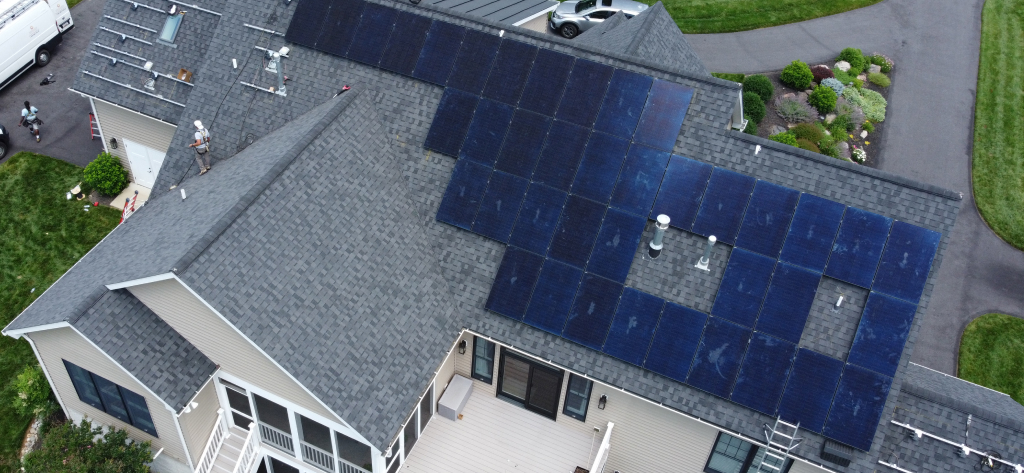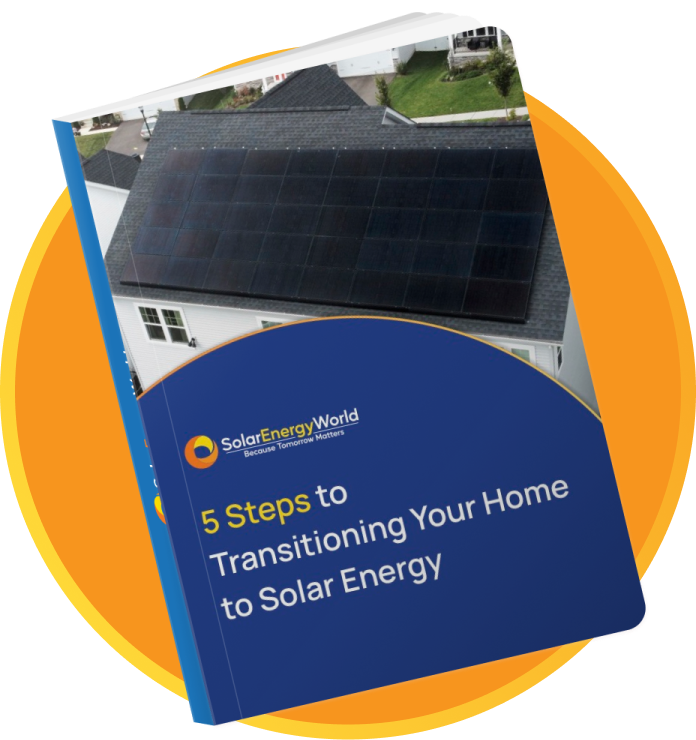Article
The Pros and Cons of Installing Solar Panels for Older Homes

With rapidly declining costs and increased incentives in 2024, switching to solar energy become more accessible than ever. While installing solar panels on any property comes with its own set of challenges, older properties require much more care before you can safely make the switch.
Benefits of Solar Panels for Older Homes
Solar panels, combined with solar batteries for energy storage, allow older homes to rely less on the traditional grid and more on the energy their home generates. This independence can lead to lower electricity costs and peace of mind that your home will stay powered regardless of what happens to the grid.
Since your panels rely on a renewable energy source, you can reduce your home’s reliance on fossil fuels to stay powered. This decreases your carbon footprint and helps contribute to creating a cleaner, greener future for our planet. There are several local, state, and federal solar incentives that make switching to solar energy more accessible to the average homeowner.
While some solar incentives — like the Investment Tax Credit (ITC) — help cover the up front cost of solar panel installation, others — like the solar renewable energy credits (SRECs) or net metering, allow you to make money on the excess energy your new system generates to reduce your overall utility bills.
Solar Panel Installation Challenges in Older Homes
Older homes weren’t made with solar panels in mind, so the roof’s structural integrity and shape may not be compatible with the switch. Homes that don’t receive enough sunlight may not be as efficient with solar energy as newer homes with more open roof space.
Older homes run a much higher risk of having outdated insulation and electrical systems than their modern counterparts. This causes homes to consume more energy, burn more fossil fuels, and increase the home’s carbon dioxide emissions. As a result, more harmful pollutants are released into the air, contributing to things like smog and respiratory illnesses.
The inefficiencies of these outdated systems can lead to much higher energy costs, increased fossil fuel use, and even safety hazards. They can also make older homes less attractive to buyers should the homeowner put it on the market.
Structural integrity can be a huge concern for older homes since roofs may need to be reinforced or electrical systems may need to be upgraded to support the solar panels. If your home is a historic property or has historic integrity, you may need specific permits or design adjustments before making any exterior changes.
Switching to solar panels can help homeowners reduce reliance on the outdated systems, save money on utility bills in the long-run, and increase their property value. This can make homes more attractive to buyers interested in properties with more sustainability features.

How to Switch to Solar in 5 Simple Steps
Solar Energy for Old Houses
The condition, design, and materials of your roof can also impact your home’s compatibility with solar panels. Solar panels can weigh about 40 pounds each. Most homes, on average, need about 15 panels to completely power their home. That means your roof and the material it’s made of must be able to comfortably support 600 pounds throughout its projected lifetime. Roofs created with more brittle materials — like slate, wooden shingles, and clay — are unable to sustain this weight and are more likely to break during installation.
The angle of your roof can affect how sunlight exposure spreads across each solar panel, which impacts the amount of energy they can generate. If your roof doesn’t receive enough sunlight or is toward the end of its lifespan, ground-mounted systems can be a good alternative if you’re set on going solar.
Modern high-efficiency solar panels allow you to generate more energy with limited roof space. If your home is partially shaded by trees or chimneys, using microinverters and power optimizers can also help improve your energy production. Using solar batteries to store excess generated energy can further improve your independence from traditional power grids.
Most solar panels can last up to 30 years even with minimal maintenance, but this performance can be impacted by your roof’s stability, historic preservation requirements, and general wear and tear. Some historical properties may require you to use design modifications or alternative mounting solutions to be compliant with local regulations.
How to Install Solar Panels on Older Homes
Before you start an installation project, have your home thoroughly assessed to determine its compatibility with a solar panel system. The assessment should include a structural inspection of your roof to ensure it’s stable enough to support solar panels, and an electrical system inspection to determine whether or not the existing wiring and electrical panels can support solar energy input. You should also have a sunlight exposure analysis to identify shaded areas that could impact the efficiency of your solar panels.
If your electrical system or roof aren’t compatible, you’ll need to upgrade them accordingly before continuing with the solar installation.
Once your home is deemed suitable, you should work with a professional to design a system suited to your home’s needs. Ideally, it will maximize energy efficiency and suit your home’s architecture. If your home has a steep roof, installers may use custom racking systems to secure the panels in place or smaller, high-efficiency panels to maximize smaller spaces. Ground-mounted systems can be a great alternative if your roof is completely unsuitable for a more traditional solar panel system. Solar installers may use low-profile to help the new system match your home’s aesthetics or place the panels in less visible locations.
Regardless of how the system is mounted, make sure to factor solar batteries into your plans to ensure your home has a consistent flow of renewable power.
When you work with expert solar installers like Solar Energy World, we stay on top of local building codes, historical preservation guidelines, and building permits so you don’t have to. Working with a solar specialist ensures your new system is installed accurately and compliantly the first time. If you live in an area with a homeowners association (HOW), you may need to check with them for specifics on their solar installation guidelines.
Once the paperwork, inspections, and upgrades have been handled, you can proceed with your solar panel installation.
The cost of evaluating your home and installing solar panels can vary by location and how much work your home needs done before you can proceed. On average, standard solar panel installation can cost around $25,000, but, with federal and state credits, you’ll likely pay less than that for your new system.
Other fees to keep in mind include:
- Roof repairs and/or replacement
- Electrical system upgrades
- Customized mounting solutions
- Permitting fees
- Roof modifications to be compliant with historic considerations
How Long Do Solar Panels Last on Older Homes?
Even with minimal maintenance, solar panels can last up to 30 years. To maximize their longevity, plan to have your panels cleaned at least twice a year. This can remove excess dust and debris built up on or around your panels, remove any nests created on the panels, and check the wiring to make sure everything is properly connected.
Having a solar monitoring system can help you keep track of your energy production and stay on top of any efficient drops. It can also help you detect any potential issues with your panels early on, allowing for prompt repairs and maintenance.
Having warranty coverage on your solar panels can protect you from the cost of unexpected repairs or efficiency losses. Ideally, your warranty should cover panel and inverter performance. Some warranties also cover racking equipment, but you should work with your installer for more specifics.
Can Solar Panels Damage an Old Roof?
Older homes are more likely to require repairs, reinforcement, or replacements before the installation can happen. The purpose of the thorough roof inspections is determine its age, lifespan, and structural integrity. Once your home is deemed suitable, the chances of solar panels damaging your roof are minimal. This chance is reduced even more when working with professional installers as they pay close attention to weight distribution, waterproofing to prevent liquid infiltrations, and the mounting system used.
Roofs are prone to leaks, structural stress, and even cracking from the materials used during its construction. Expert installers create and execute detailed plans to ensure your home benefits from solar energy while maintaining the structural integrity of your roof.
Weighing the Pros and Cons of Solar Panels for Older Homes
Solar panels for older homes can reduce your utility bills and decrease your reliance on fossil fuels to help build a more eco-friendly planet. While the initial investment seems high at first, with solar incentives and tax credits on federal, state, and local levels, you can offset the full price of installation costs. Additionally, you can decrease your reliance on the traditional power grid to be more energy efficient.
Before you start a full-scale solar panel installation on an older home, make sure to evaluate:
- Your roof’s structural integrity and age
- Local regulations and restrictions
- Available solar incentives
- Long-term energy needs
By carefully considering these factors, you can determine whether or not solar energy is the best fit for your older home. Need help making an informed decision that balances cost, efficiency, and sustainability? Schedule your FREE solar estimate today!et your needs and safeguard your family! Get started today with a free solar estimate!
Want a Free Solar Estimate?
Fill out the form to get started today.

